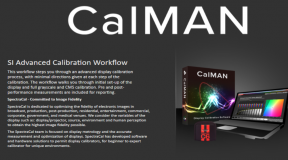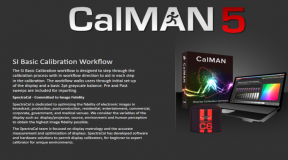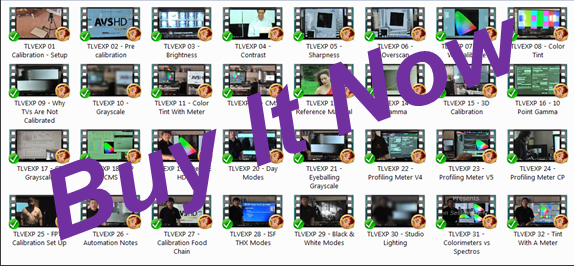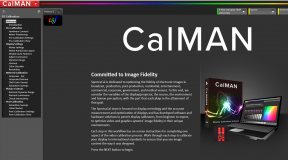THX Video Systems Calibration
The THX Video Systems Calibration Program is now four years old as the first official class was at Skywalker Ranch in December 2007. The class travels around the U.S. to various cities and has made a stop in Canada and now at overseas locations. There is usually a class attached to trade shows like the Consumer Electronic Show and the CEDIA shows each year as well as other shows.
It was a “stand alone” three day program up until September of 2010 when the program was split into two separate classes; a Level 1 one day entry level class and a Level 2 two day class. In most cases if one just signs up for both classes, the material is exactly the same as the original three day class. Some material had to be juggled around to accommodate the two class structure. Level 1 was meant to give people a taste of what the program will be like and a preview of how the business of calibration truly functions. It allows potential calibrators to bail out early without committing too many resources into something that is not right for them.
For a person to represent themselves as a “THX Certified Video Professional,” attendance in both classes is required. Attendance in only the Level I class provides the attendee with the more generic “THX Certified Professional” title. Yes, this type of labeling can be confusing and the true distinction between Level 1 and Level 2 will be completely lost on the average consumer that might be looking into calibration services. We knew that, but it was something that the THX machine wanted. (Fortunately, the Level 1 people do not get listed on the THX site or anywhere else. They also lose their designation after two years.)
For alumni of the ISF program, THX Video Level 1 is free of charge so long as they sign up for the Level 2 class. The Level 1 class may be free of charge, but attendance in the class is still mandatory for all of the ISF alumni. An exemption is granted if the student can answer correctly four questions about the business of calibration. (To this day, no one has correctly answered even one of the questions to gain the exemption.)
The introduction of the Level 1 class in September 2010 went over like a lead balloon. The class was offered at $49 a head for a period of four months and while attendance was high, carry over to the Level 2 class was very disappointing. THX certification could be bought for a mere $49 and people came from all over, without any intention of taking the Level 2 class. We were at least successful at convincing the powers at THX that offering the class for free was a very bad idea. Homeless people could have attended the class if only to get a hot meal.
I think they learned that it was not the price of the class that kept people away. No more offerings of the class at next to nothing.
The basic structure of the class is three days of class time running from 9:00 AM to 6:00 PM. The class actually unofficially ends at about 4:30 PM on the third day and the attendees help to disassemble and pack the equipment in the room. At the end of the first day of class, the classroom itself remains open until as late as 11:00 PM as students are highly encouraged to stay late and get more hands on practice time under supervised conditions. The instructors will stay until the last student leaves the room or until it hits 11:00 PM. Even those just attending the Level 1 class are encouraged to stay and try out the test gear, but most just leave when it hits 6:00 PM. Those taking both classes almost always use this extra time.
Practice time actually continues at 7:00 AM on days 2 and 3 as well before the official 9:00 AM start time. There are up to an additional 14 hours of hands on practice time available to the students in this program. (Students at overseas venues will have different results depending on where the class is held.) No one has ever complained that the class did not offer the students enough hands on practice time, if anything, students have gotten burned out by the afternoon of the third day. This has been termed “calibration fatigue.”
Within the class itself, the material has been typically presented by two instructors who constantly switch out from subject to subject. The teaching styles of the two instructors have been described as wildly different, but this approach has helped to keep the material fresh and the students more attentive and focused. The presentation is kept very informal and light hearted. Hands on practice time within the class usually amounts to approximately 10 hours of the 24 hours over the three days; that leaves about 14 hours for actual lecture time. The format of the class is also very loose as opposed to regimented. Washroom breaks are plentiful and one instructor has been heard to say that a coffee cup is never far from his hand nor is his need to go to the washroom.
The students can practice on the class equipment which typically has included at least eight flat panel displays and four to five projectors. The typical class has a student to display ratio of sometimes less than one to no more than two students per display rather than crowding five to six students around one display and only half those students get any quality time with the practical learning.
Calibration fundamentals taught in the THX class are similar to those taught in the competing ISF class. Everyone teaches to the SMPTE (Society of Motion Picture and Television Engineers) specifications for displays. The THX program then adds some of their specific philosophies where there is not a specific answer from SMPTE.
The elements that make the THX class distinctly different from other classes are not in the calibration fundamentals themselves, but rather the way the information is presented to the students. There is a lot of scientific theory behind the concepts in the calibration process, enough to spin heads and put people to sleep. The instructors know this and as a direct result, all the material is presented in a format without any technical terminology so that someone passing on the street could be brought in and could understand the material. Terminology is brought in at times, but just as quickly redefined into something more relatable.
The strength of the program is that the material is all presented in a fashion that people can easily relate to and hence more easily remember. The practice is to present all the concepts in the form of amusing stories that the listeners can remember. If they can remember the story, they will also remember the concept behind the story. This makes it easier when talking to a client since the same stories can then be relayed to them in an easy to understand format.





